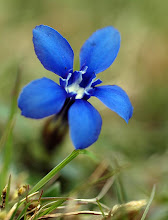Friday, February 24, 2012
Seaweed Sexual Reproduction: a chancy business
This is a transverse section of the conceptacle of a brown seaweed Fucus sp., commonly known as saw wrack. It has been stained with a fluorescent dye called anilino-naphthalene-sulphonic acid.
Brown seaweeds in the genus Fucus are common in the intertidal zone. Two species are visible here - saw wrack Fucus serratus with a saw-tooth edge to the fronds and bladder wrack F. vesiculosus with smooth frond edges and paired flotation bladders. In spring they make rapid new growth and enter their reproductive phase, producing swollen receptacles at the end of the fronds.
The receptacles are covered in large numbers of small swellings called conceptacles, each of which opens via a minute pore called the ostiole (double click image to enlarge).
This is a section through a receptacle showing two conceptacles developing inside. This is from a female conceptacle. The radiating, elongated filament-like structures are sterile hairs (paraphyses) and the club-shaped structures are oogonia, each of which produces eight eggs (oospheres)....
...... and here is an egg (oosphere) being liberated from an ostiole into the surrounding water. Inside the conceptacle some oogonia are still dividing by meiosis to produce oospheres - you can see the cell walls forming.
When the conceptacles are mature eggs and vast numbers of swimming male cells (antherozoids) are liberated into the water of the rising tide - most prolifically during spring tides - and at high tide the eggs are fertilised, if they are lucky, and carried away by the falling tide. If they're luckier still the fertilised zygotes attach to a rock and develop into a new seaweed. The clusters of small bright yellow structures that you can see here amongst the rounded oospheres are the antheridia that produce the antherozoids - this conceptacle is hermaphrodite, showing that it came from spiral wrack Fucus spiralis; saw wrack and bladder wrack have conceptacles that are either male or female.
You can find images of thin sections and male and female conceptacles of fucoid seaweeds here, more detailed information on their structure and life cycle here and more on Fucus and other seaweeds here.
Subscribe to:
Posts (Atom)


















